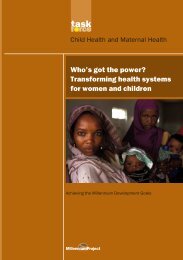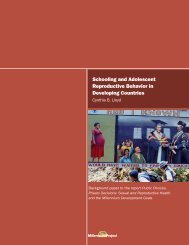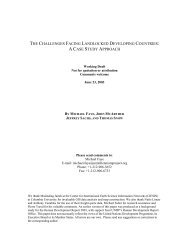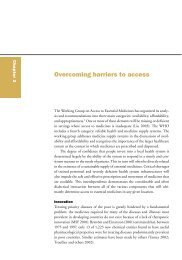Public Choices, Private Decisions: Sexual and Reproductive Health ...
Public Choices, Private Decisions: Sexual and Reproductive Health ...
Public Choices, Private Decisions: Sexual and Reproductive Health ...
You also want an ePaper? Increase the reach of your titles
YUMPU automatically turns print PDFs into web optimized ePapers that Google loves.
64 <strong>Sexual</strong> <strong>and</strong> <strong>Reproductive</strong> <strong>Health</strong> <strong>and</strong> the Millennium Development Goals<br />
There is<br />
a strong<br />
incentive<br />
for larger<br />
families to<br />
keep children,<br />
especially<br />
girls, at home<br />
<strong>and</strong> out of<br />
school<br />
Most empirical studies on educational attainment in countries where family<br />
size has been on the decline have found that a child’s school attainment is negatively<br />
associated with the number of siblings with whom the child lives (National<br />
Research Council <strong>and</strong> Institute of Medicine 2005). Throughout the 1990s this<br />
relationship was investigated in a number of developing countries, <strong>and</strong> this result<br />
was often found to be the case (though the size <strong>and</strong> statistical significance of this<br />
relationship varied greatly between settings) (Lloyd 1994).<br />
There is also evidence from these studies that the gender gap in educational<br />
attainment may be explained by parental preference for sending boys to school<br />
when a family has limited resources (National Research Council <strong>and</strong> Institute<br />
of Medicine 2005). There are two possible explanations for this. Firstly, parents<br />
choosing to have fewer children are also less likely to discriminate against girls.<br />
Secondly, girls may have more siblings than boys <strong>and</strong> face greater resource constraints<br />
as a consequence. This explanation is more relevant to societies with high<br />
fertility rates <strong>and</strong> strong son preference. Gender disparities in education, then,<br />
would decrease with falling family size, as girls would no longer be likely to come<br />
from larger families. Jensen (2003) found this to be the case in India, where gender<br />
disparities in education occurred because girls tended to have more siblings<br />
than boys <strong>and</strong> children in larger families often had less schooling.<br />
But caution should be used when interpreting results from many of these<br />
analyses. While these studies found family size to be significantly associated with<br />
schooling, the estimated effects were often relatively small compared to other<br />
factors (see literature review by Kelley 1996 <strong>and</strong> Lloyd 1994). A recent Brazilian<br />
study, for example, found that declining family size was one of the factors<br />
contributing to the rising school enrolment rates in the 1990s. The number of<br />
siblings aged 0–6 had negative impacts on the child’s school enrolment, with a<br />
slightly more negative impact on girls over boys. There was also a negative effect<br />
of siblings aged 7–17, though this effect was much smaller (Lam <strong>and</strong> Marteleto<br />
2002). But this impact, while significant, had less influence on enrolment rates<br />
than did parental schooling, which accounted for a substantial proportion of<br />
the increase in rates. Furthermore, many investigations also found that the relationships<br />
between family size <strong>and</strong> schooling were mediated by other contextual<br />
factors including level of economic development, government expenditure on<br />
education, phase of the demographic transition <strong>and</strong> family structure.<br />
Level of economic development<br />
Some level of economic development is required for family size to have an impact<br />
on schooling. If a community is without a school, then clearly family size will<br />
have no effect on children’s educational attainment. Similarly, if parents perceive<br />
schools to be of poor quality, unsafe or located far from the home, they are likely<br />
to question the benefit of sending children to school, no matter the size of their<br />
family. Evidence of the importance of economic development on the relationship<br />
between family size <strong>and</strong> schooling has been found in some studies where larger
















